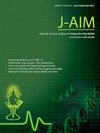Scientific characterization of the Siddha medicine Pavala parpam manufacturing
IF 1.9
Q3 INTEGRATIVE & COMPLEMENTARY MEDICINE
引用次数: 0
Abstract
Background
In general, various Siddha medicine manufacturing methods are reported without comprehensive scientific quantification of the process and product at various manufacturing stages.
Objective
The current work aimed to study the standard manufacturing method involved in the pavala parpam medicine preparation and characterization.
Materials and methods
The raw material for the pudam process was prepared by purifying the pavalam using lemon juice and ground with thelkodukku (Heliotropium indicum) decoction. Raw material was taken in a sealed agal for the pudam process cow dung cakes. The process parameter of the pudam process was recorded. After the pudam process, the finished medicine was ground using nannikal kalvam. The pavala parpam was characterized using Thermogravimetry (TG), X-ray diffraction analysis (XRD), X-ray fluorescence (XRF), Energy dispersive X-ray analysis (EDAX), Fourier transforms infrared spectroscopy (FTIR), Scanning electron microscopy (SEM), and a particle size analyzer.
Results
The maximum temperature of 680°C during the pudam process was recorded at the top location of the sealed agal, and the holding time above 500°C was observed to be 55 min, 75 min, and 122 min at the top, inside, and bottom locations, respectively. The analytical testing of pavala parpam shows the presence of calcium carbide, calcium oxide, and magnesium oxide.
Conclusion
The pressure developed during the pudam process was only 25–30 mbar, and it can be assumed that the pudam process happens at atmospheric pressure. 1 kg of raw materials yields 920 g of pavala parpam. The characterization of pavala parpam was done using modern scientific testing methods.
科学表征悉陀药帕瓦拉帕帕姆的制造
一般来说,各种Siddha药物制造方法的报道没有在各个制造阶段对工艺和产品进行全面的科学量化。目的研究巴伐拉帕帕姆药物制备和表征的标准制备方法。材料与方法:采用柠檬汁提纯巴伐兰,再用枸杞水煎剂研磨,制备了巴伐兰制浆工艺的原料。牛粪饼的原料是在一个密封的容器中提取的。记录了该工艺的工艺参数。在普丹过程之后,成品药被用nannikal kalvam磨碎。采用热重法(TG)、x射线衍射分析(XRD)、x射线荧光(XRF)、能量色散x射线分析(EDAX)、傅里叶变换红外光谱(FTIR)、扫描电镜(SEM)和粒度分析仪对pavala parpam进行了表征。结果封口琼脂顶部最高温度为680℃,顶部、内部和底部500℃以上保温时间分别为55 min、75 min和122 min。帕瓦拉帕帕姆的分析测试表明存在电石,氧化钙和氧化镁。结论发胶过程产生的压力仅为25 ~ 30 mbar,可以认为发胶过程发生在常压下。1公斤原料可生产920克帕瓦拉帕帕姆。用现代科学的测试方法对帕瓦拉帕姆进行了表征。
本文章由计算机程序翻译,如有差异,请以英文原文为准。
求助全文
约1分钟内获得全文
求助全文
来源期刊

Journal of Ayurveda and Integrative Medicine
INTEGRATIVE & COMPLEMENTARY MEDICINE-
CiteScore
4.70
自引率
12.50%
发文量
136
审稿时长
30 weeks
 求助内容:
求助内容: 应助结果提醒方式:
应助结果提醒方式:


